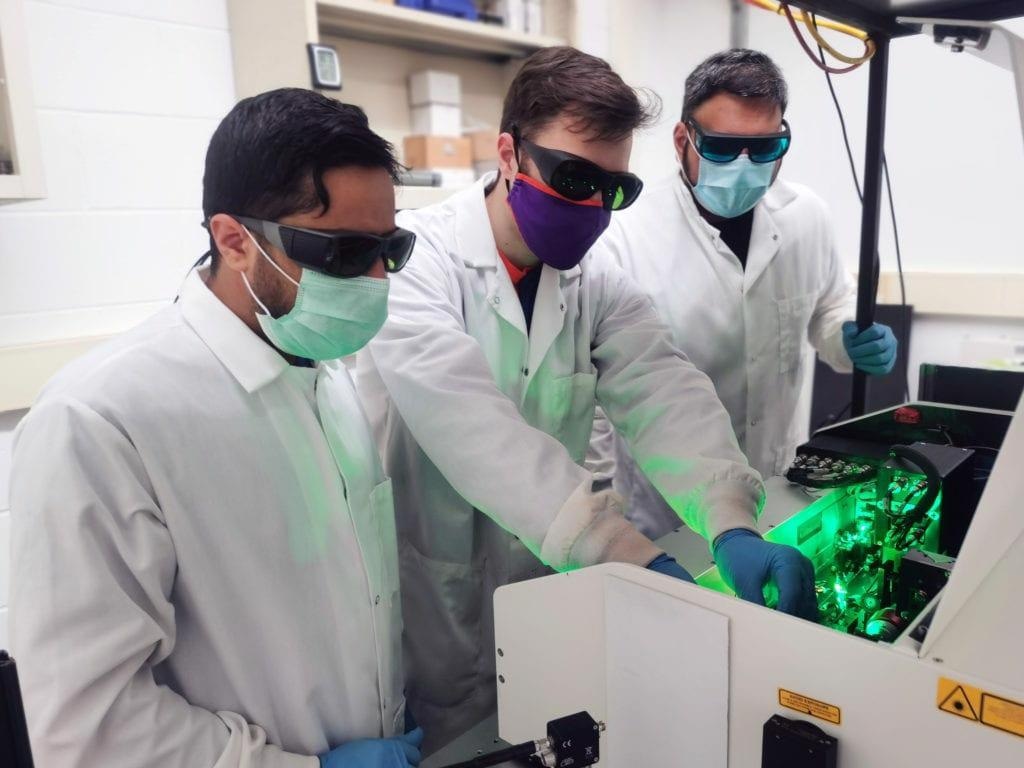Mar 15 2021
By applying laser spectroscopy in a photophysics experiment, scientists from Clemson University have made a new breakthrough that may lead to faster and more affordable energy to drive electronics.
 From left, Pan Adhikari, Lawrence Coleman, and Kanishka Kobbekaduwa align the ultrafast laser in the Department of Physics and Astronomy’s UPQD lab. Image Credit: Clemson University.
From left, Pan Adhikari, Lawrence Coleman, and Kanishka Kobbekaduwa align the ultrafast laser in the Department of Physics and Astronomy’s UPQD lab. Image Credit: Clemson University.
This innovative method, based on solution-processed perovskite, is intended to transform a wide range of day-to-day objects, including photodetectors, LEDs, and solar cells for computer chips and smartphones.
Solution-processed perovskites are advanced materials designed for solar cell panels used on rooftops, LEDs for daily-life lighting, and X-ray detectors for medical diagnosis.
Perovskite materials are designed for optical applications such as solar cells and LEDs. It is important because it is much easier to synthesize compared to current silicon-based solar cells. This can be done by solution processing—whereas, in silicon, you have to have different methods that are more expensive and time-consuming.
Kanishka Kobbekaduwa, Study First Author and Graduate Student, Clemson University
The objective of this study is to make materials that are easier, cheaper, and more efficient to create.
About the Research Team
The researchers included two graduate students and one undergraduate student, who are all guided by Jianbo Gao, a group leader of the Ultrafast Photophysics of Quantum Devices (UPQD) group in the Department of Physics and Astronomy at the College of Science.
The collaborative study was recently published in the high-impact journal, Nature Communications, on March 12, 2021. The paper is titled “In-situ Observation of Trapped Carriers in Organic Metal Halide Perovskite Films with Ultra-fast Temporal and Ultra-high Energetic Resolutions.”
Gao is the principal investigator of the study and is also an assistant professor of condensed matter physics. The co-authors of the study are graduate student Kanishka Kobbekaduwa (first author) and graduate student Pan Adhikari from the UPQD group, and undergraduate Lawrence Coleman, who is also a senior in the physics department.
Other authors of the study from Clemson University included Apparao Rao, the R.A. Bowen Professor of Physics, and Exian Liu, a visiting student from China.
The exclusive technique employed by Gao’s research team—that is, using ultrafast photocurrent spectroscopy—enabled a relatively higher time resolution when compared to the majority of the techniques, to establish the physics of the trapped carriers. In this case, the effort is quantified in picoseconds, which are one trillionth of a second.
We make devices using this (perovskite) material and we use a laser to shine light on it and excite the electrons within the material. And then by using an external electric field, we generate a photocurrent. By measuring that photocurrent, we can actually tell people the characteristics of this material. In our case, we defined the trapped states, which are defects in the material that will affect the current that we get.
Kanishka Kobbekaduwa, Study First Author and Graduate Student, Clemson University
As soon as the physics are established, scientists can easily detect the defects and these flaws eventually produce inefficiency in the materials. When the defects are passivated or reduced, this can lead to increased efficiency, which is crucial for various devices, including solar cells.
When materials are produced via solution processes, such as inkjet printing or spin coating, there is a greater chance of introducing defects. Such low-temperature processes are more cost-effective when compared to ultra-high temperature techniques that lead to a pure material. However, these processes also create more defects in the material. Therefore, striking a balance between both methods can lead to more efficient and higher-quality devices at lower costs.
By analyzing that current, we are able to see how the electrons moved and how they come out of a defect. It is possible only because our technique involves ultrafast time scale and in-situ devices under an electrical field. Once the electron falls into the defect, those who experiment using other techniques cannot take that out.
Pan Adhikari, Ultrafast Photophysics of Quantum Devices Group, Department of Physics and Astronomy, College of Science, Clemson University
Adhikari added, “But we can take it out because we have the electric field. Electrons have charge under the electric field, and they can move from one place to another. We are able to analyze their transport from one point to another inside the material.”
The team tested the substrate specimens by sending a laser toward the material to find out how the signal travels via it. The use of a laser to light up the samples and obtain the current made the study feasible, and also made it different from other experiments in which an electric field is not used.
Both the transport and the impact of material defects on it can influence the performance of those devices and materials in which they are utilized. These analyses are all part of the significant findings that students are making under the direction of their mentor, producing ripples that will result in the next major innovation.
Gao added, “The students are not only learning; they are actually doing the work. I am fortunate to have talented students who—when inspired by challenges and ideas—will become influential researchers.”
“This is all part of the important discoveries that students are making under the guidance of their mentors, creating ripples that will lead to the next great breakthrough. We are also very grateful for the strong collaborations with Shreetu Shrestha and Wanyi Nie, who are top materials scientists from Los Alamos National Laboratory,” Gao concluded.
The study was supported by the Center for Integrated Nanotechnology at Los Alamos National Laboratory in Los Alamos in New Mexico, and also by the South Carolina Research Authority.
Journal Reference:
Kobbekaduwa. K., et al. (2021) In-situ Observation of Trapped Carriers in Organic Metal Halide Perovskite Films with Ultra-fast Temporal and Ultra-high Energetic Resolutions. Nature Communications. doi.org/10.1038/s41467-021-21946-2.